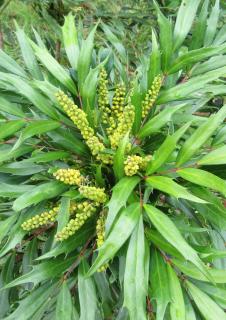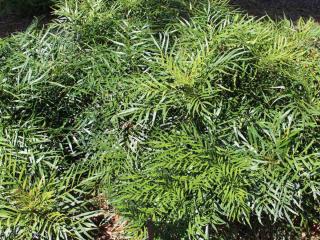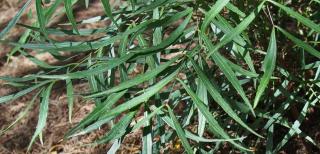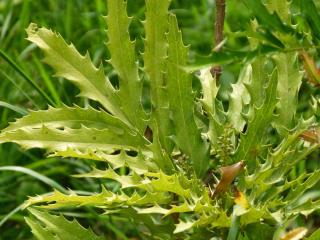

Native to China, Mahonia eurybracteata was brought to us only two decades ago.
Mahonia eurybracteata facts
Name – Mahonia eurybracteata
Former name – Mahonia confusa
Family – Berbericaceae (barberry)
Type – evergreen low shrub
Height – about 3′ tall (1m)
Exposure: part sun or shade – Soil: average, better if rich – Blooming: fall
Growing this plant in your garden will definitely give it an elegant Asian touch! This mahonia plant with wispy, bamboo-like leaves will stand out in both gardens and planters.
The variety most often found in stores is the Mahonia ‘Soft Caress’.
You’ll generally find the Mahonia eurybracteata in the form of potted shrubs.
Follow these guidelines on how to plant a shrub.

It thrives most in shade or part shade, so you can plant it in the following situations:
Seeds can be sown in late winter in nursery pots, indoors.
Cuttings are a sure way to get an exact match, and it also blooms earlier. Seed-grown shrubs tend to have a longer lifespan.
Cuttings and layering are two very effective ways to propagate your M. eurybracteata.
These techniques do work very well. When preparing cuttings, it’s best to select stems at the end of summer.
When air-layering or marcotting, remember to stake the stem you’re working with.
Your Mahonia eurybracteata will bear hundreds of berries, each of which contains from 2 to 5 seeds. That’s a lot of sowing power!
This Mahonia will send out shoots from the base. It’s possible to split the plant clump with a sharp spade.
This shrub will fend off on its own in the ground, but in pots you must water and give it fertilizer.
Watering M. eurybracteata
Only during the first year will you need to water the plant. Indeed, the root system isn’t very developed at the start, and it’s important to help it through the first summer heat waves.
M. eurybracteata can develop quite a deep root system if need be, with time.
Fertilizer
Not much fertilizer is needed. It will survive on poor soil, but for it to thrive you must give it some sort of fertilizer at least yearly.

There usually isn’t any need to prune the plant. All the species and cultivars won’t grow very large for a shrub. Expect it to reach a maximum size of 1 yard or meter tall and wide.
Usually, these hardy plants are slow growers. They’re easy to keep under control. If, however, they start growing too large for the plot of land you’ve allocated to them, there are several things you can do:
This shrub is rather hardy, coping with cold weather dropping down to 14-15°F (-10°C).
You can protect the plant in winter if it gets any colder. Depending on the species and cultivar, some leaves might turn red and/or fall off during stark freezing.

There aren’t many diseases or pests that will attack your plant. It’s still rare to see such plants, and local diseases haven’t yet taken hold on it.
You might notice aphids in spring, especially if ants are nearby.
More and more special, beautiful varieties have appeared on the market, here are some of the most amazing.
 Mahonia eurybracteata ‘Beijing beauty’ – leaves are laced with small teeth
Mahonia eurybracteata ‘Beijing beauty’ – leaves are laced with small teethBotanists distinguish two main types of Mahonia eurybracteata.
You’ll be immediately swayed off your feet when you first set your eyes on a wonderful Mahonia eurybracteata plant.
The beautiful thin leaves are soft and don’t have the typical “Mahonia spine” thorns or pricks on them. They’re still quite leathery to the touch, though, which makes them feel smooth (and helps fight drought, too).
Usually, the deep olive-green to silver-blue leafage is evergreen. In only turns red and falls in the coldest of regions.
And when the sun starts feeling far away, in fall, a power-packed yellow bloom takes you by surprise with a scent similar to that of the yellow mimosa tree.
Mahonia eurybracteata, like its cousins in the Mahonia genus, has many uses. For example, it can be used to dye food and clothes.
It’s perfectly possible to eat the berries that form afterwards: Mahonia eurybracteata berries are edible.
It’s native to Chinese area. Recently, new varieties have been introduced. Almost all varieties available in English-speaking countries are protected by patents.
Specifically, some of the native varieties are endemic to the Sichuan province. As such, they grew up near the famed Sichuan pepper tree!
These wonderful shrubs look like bamboo without any of the invasive drawbacks – they are excellent for Japanese gardens!